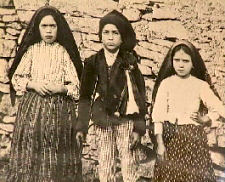Our Lady of Fatima
 The famous apparitions of the Virgin Mary to the children of Fatima took place during the First World War, in the summer of 1917. The inhabitants of this tiny village in the diocese of Leiria (Portugal) were mostly poor people, many of them small farmers who went out by day to tend their fields and animals. Children traditionally were assigned the task of herding the sheep.
The famous apparitions of the Virgin Mary to the children of Fatima took place during the First World War, in the summer of 1917. The inhabitants of this tiny village in the diocese of Leiria (Portugal) were mostly poor people, many of them small farmers who went out by day to tend their fields and animals. Children traditionally were assigned the task of herding the sheep.
The three children who received the apparitions had been brought up in an atmosphere of genuine piety: Lucia dos Santos (ten years old) and her two younger cousins, Francisco and Jacinta. Together they tended the sheep and, with Lucy in charge, would often pray the Rosary kneeling in the open. In the summer of 1916 an Angel appeared to them several times and taught them a prayer to the Blessed Trinity.
On Sunday, May 13, 1917, toward noon, a flash of lightning drew the attention of the children, and they saw a brilliant figure appearing over the trees of the Cova da Iria. The “Lady” asked them to pray for the conversion of sinners and an end to the war, and to come back every month, on the 13th.
Further apparitions took place on June 13 and July 13. On August 13 the children were prevented by local authorities from going to the Cova da Iria, but they saw the apparition on the 19th. On September 13 the Lady requested recitation of the Rosary for an end to the war. Finally, on October 13, the “Lady” identified herself as “Our Lady of the Rosary” and again called for prayer and penitence.
On that day a celestial phenomenon also took place: the sun seemed to tumble from the sky and crash toward earth. The children had been forewarned of it as early as May 13, the first apparition. The large crowd (estimated at 30,000 by reporters) that had gathered around the children saw the phenomenon and came away astounded.
Official recognition of the “visions” which the children had at the Cova da Iria came on October 13, 1930, when the bishop of Leiria – after long inquiry – authorized the cult of Our Lady of the Rosary at the site. The two younger children had died: Francisco (who saw the apparition but did not hear the words) on April 4, 1919, and his sister Jacinta on February 20, 1920. Sister Lucia died on February 13, 2005, at her Carmelite convent in Coimbra, Portugal, after a long illness.
—Excerpted from Dictionary of Mary, Catholic Book Publishing Company.
 The public message of Fatima recalls that of Lourdes. Through the children Mary urges prayer for sinners, recitation of the Rosary, and works of penance. On October 13 she said: “I have come to exhort the faithful to change their lives, to avoid grieving Our Lord by sin; to pray the Rosary. I desire in this place a chapel in my honor. If people mend their ways, the war will soon be over.”
The public message of Fatima recalls that of Lourdes. Through the children Mary urges prayer for sinners, recitation of the Rosary, and works of penance. On October 13 she said: “I have come to exhort the faithful to change their lives, to avoid grieving Our Lord by sin; to pray the Rosary. I desire in this place a chapel in my honor. If people mend their ways, the war will soon be over.”
But Mary also confided several “secrets” to the children, some of which Lucy subsequently transmitted. Presumably there was prediction of another war in the near future and a request for special veneration of the Immaculate Heart of Mary. The final secret Lucy is thought to have entrusted to Pope John XXIII.
As at Lourdes, the “apparitions” of Fatima have brought crowds of visitors. Pilgrimages, which began in the summer of 1917, have experienced growing success, not only among the Portuguese themselves but also among people from other countries, including the United States. The national pilgrimage following ecclesiastical recognition of the apparitions (May 13, 1931) is said to have drawn more than a million participants.
Popes have shown exceptional favor toward Fatima, Pius XII, Paul VI, and John Paul II in particular making a visit to the shrine. The papal interest and the basilica built at the site of the apparitions has helped to swell the summer pilgrimages to Fatima. Crowds comparable to, and sometimes larger than, those at Lourdes are not uncommon. In a rustic setting, pilgrims hear the message repeated that Mary spoke to the children: prayer, works of penance, recourse to her Immaculate Heart.
—Excerpted from Dictionary of Mary, Catholic Book Publishing Company
